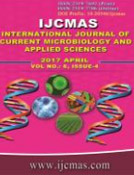


 National Academy of Agricultural Sciences (NAAS)
National Academy of Agricultural Sciences (NAAS)

|
PRINT ISSN : 2319-7692
Online ISSN : 2319-7706 Issues : 12 per year Publisher : Excellent Publishers Email : editorijcmas@gmail.com / submit@ijcmas.com Editor-in-chief: Dr.M.Prakash Index Copernicus ICV 2018: 95.39 NAAS RATING 2020: 5.38 |
Recombination is a process by which pieces of DNA are broken and recombined to produce new combinations of alleles. In 1964, Robin Holliday proposed a model for understanding molecular basis of recombination that accounted for heteroduplex formation and gene conversion during recombination. A new modified major model for recombination was given by Jack Szostak and colleagues in 1983, it is called the double-strand-break model. The initial steps in finding enzymes that carry out recombination were genetic screens for mutants of E. coli that are defective in recombination. One of the major pathways for generating 3’ single-stranded termini uses the RecBCD enzyme. The pairing of the two recombining DNA molecules (synapsis) and invasion of a single strand from the initiating duplex into the other duplex are both catalyzed by the multi-functional protein RecA. RuvA tetramers recognize the Holliday junction, and RuvB uses the energy of ATP hydrolysis to unwind the parental duplexes and form heteroduplexes between them. Ruv C is the endonuclease that cleaves the Holliday junctions. In eukaryotes, spo11 protein introduces DSBs in chromosomal DNA at many locations to initiate meiotic recombination. MRX protein processes the cleaved DNA ends for assembly of the RecA-like strand exchange proteins. Dmc1/ Rad51 is a RecA-like protein that specifically functions in meiotic recombination.
 |
 |
 |
 |
 |